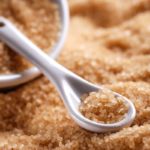Are Melted Sugar And Caramelized Sugar Different Things?
The method of melting sugar changes depending on what kind of sweet treat you’re trying to make.
Melting sugar to make a sweet glaze for a doughnut is a shorter process than making caramelized sugar, which is a different end product- used for caramel sauce and caramel candies.
There are also many varying degrees of melted sugar in between with all sorts of different uses- so pay close attention to the recipe that you’re following so that you know exactly what colour and consistency your melted sugar should be.
We also look at how you caramelize sugar.
How To Melt Sugar
Uses Of Melted Sugar
As granulated sugar melts in a solution with water, it quickly develops a whole variety of uses.
Melting sugar means it can be used as:
Cocktail Sweetener
A basic sugar syrup is a common ingredient in many cocktails, such as Margaritas- just a dash will cut straight through all those tough bitter flavors.
Sugar Glaze
Melted sugar is also a very common topping for cakes and many baked goods, such as doughnuts. See also: Caramel sauce.
Sugar Glass
Add a small amount of corn syrup to melted sugar, pour onto a baking sheet and give it a few hours to harden- that’s how easy it is to make sugar glass. Use tastefully for some interesting dessert sculptures!
Sugar Syrup
Wider uses of sugar syrup include being used sparingly as a drizzle or a glaze over baked goods, where it dries hard.
It can also be used more liberally in desserts that are too tart or not sweet enough.
Notes On Brown Sugar
It is possible to use brown sugar for melted or caramelized sugar, but it is much harder to do and the taste is much different.
You would need to cook it at a medium heat to fully complete the melting process and bring it to its boiling point, as the granules are much larger.
If you are looking to caramelize sugar using brown sugar, then you should also consider that as it reaches its boiling point it will remain a similar golden brown color to completely caramelized sugar.
You can use a candy thermometer to check that it has reached 340 to 350 °F (171 to 177 °C), which is the caramelizing point of granulated sugar.
1. Measure Out The Correct Amount Of Sugar
This is a lot more important than you may think. It is difficult to melt sugar without burning it, so we don’t recommend melting more than two cups at a time.
Also consider that different amounts of sugar in different amounts of water create different types of melted sugar.
If you need more than two cups for your recipe, do separate batches.
For melted sugar, you must use white granulated sugar.
Two cups of melted granulated sugar will make one cup of caramel.
2. Place The Sugar With Cold Water In A Pot
Ensure that the pot is entirely free of sediment before you begin, as sugar crystals like to form around tiny objects.
The rule of thumb when creating the mixture is to use half the amount of water to sugar in the recipe, in terms of weight- too much water and you risk making sugar-water.
Using a heavy bottomed pot more evenly spreads the heat, and a wooden spoon makes stirring continuously much easier.
3. Melting Sugar On A Medium-Low Heat
Melting sugar slowly is the only way to do so without burning it, which can happen very easily anyway.
Continuously stir the melting sugar with a wooden spoon to break up any lumps and make sure that nothing sticks to the bottom of the pan.
Absolutely anything within the mixture that isn’t smooth will burn very quickly.
Continue stirring until the melted sugar mixture is clear and reaches the boiling point. This should only take a few minutes.
From this point, you must use your recipe to decide at which final temperature the sugar finishes boiling, depending on its use.
Spun sugar recipes for example, require the bottom of the pot to be submerged instantly in ice water to prevent it from cooking further.
Remove the pot of melted sugar from the boil- unless you are making caramel, in which case read on.

How To Make Caramelized Sugar
Uses Of Caramelized Sugar
Caramel is a different form of melted sugar, easily made with a little care taken with just a few extra steps. Caramelized sugar makes:
Caramel Candies
This is a thicker form of caramel sauce that can be molded into shapes and hardens, sometimes requiring lemon juice to help it thicken. Often covered in chocolate.
Caramel Sauce
Can be used as a topping or filling for baked goods (like doughnuts) or ice-cream.
1. Continue Boiling Sugar For 8-10 Minutes
Continue to boil the sugar at a low heat for another 8 to 10 minutes without stirring, to avoid forming sugar crystals.
If at any point the cooking process appears to be uneven, you can swill the pan gently.
You know when you are making caramelized sugar when the outside of the mixture has turned a faint golden brown.
2. Monitor Caramel Sauce For Consistency
At this stage, much like with the simple melted sugar, different recipes call for different practices.
For Caramel Sauce
Continue boiling until the caramelizing sugar is a rich, golden brown. At 340 to 350 °F (171 to 177 °C) it is caramel, but in its liquid form.
To check if it is really golden brown, place a spoonful of the mixture onto a white plate. Cooking for longer will make your final cooled caramel thicker.
For Hard Caramel
If you are caramelizing sugar for caramel candies, then you will need to boil for longer at a low heat. Adding lemon juice to your mixture helps the sucrose in the mixture turn into glucose.
Once the caramelizing sugar has thickened significantly, it can be molded into shape as it cools for use in candies.










